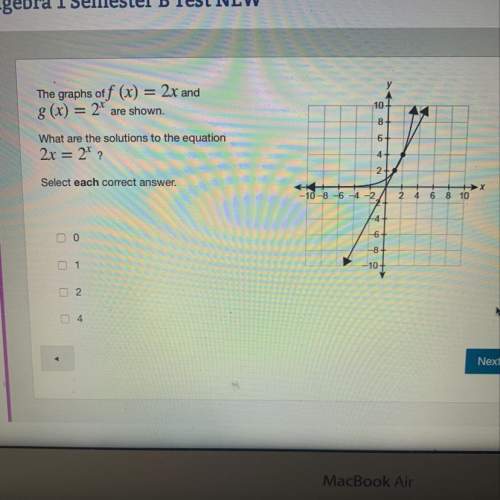
Mathematics, 28.07.2020 23:01 IsoSaysHi
Kathleen and Arnob both run from the park entrance along a loop. Kathleen starts walking from the park entrance and gets a 5-mile head start on Arnob. The graph shows how far they have both traveled. A coordinate grid labeled Distances Traveled with Time in minutes along the horizontal x-axis and Distance in miles along the vertical y-axis with 2 lines. The first line is labeled y equals (StartFraction 1 over 15 EndFraction) x plus 5 and passes through (0, 5) and (60, 9). The second line is labeled y equals (StartFraction 2 over 15 EndFraction) x. The lines appear to intersect at between 70 and 80 along the x-axis and 10 on the y-axis. How many minutes does it take Arnob to catch up to Kathleen?

Answers: 1
Another question on Mathematics

Mathematics, 21.06.2019 17:30
One integer is 8 times another. if the product is 72, then find the integers
Answers: 2

Mathematics, 21.06.2019 18:00
What power can you write to represent the volume of the cube shown? write the power as an expression with a base and an exponent and then find the volume of the cube
Answers: 3

Mathematics, 21.06.2019 21:30
Olive's solar powered scooter travels at a rate of 30 miles per hour. what equation can she use to calculate her distance with relation to the time she traveled? h=hours m=miles 1. h=m+30 2. m=30h 3. m=h+30 4. h=30m
Answers: 2

Mathematics, 21.06.2019 21:30
In a test for esp (extrasensory perception), the experimenter looks at cards that are hidden from the subject. each card contains either a star, a circle, a wave, a cross or a square.(five shapes) as the experimenter looks at each of 20 cards in turn, the subject names the shape on the card. when the esp study described above discovers a subject whose performance appears to be better than guessing, the study continues at greater length. the experimenter looks at many cards bearing one of five shapes (star, square, circle, wave, and cross) in an order determined by random numbers. the subject cannot see the experimenter as he looks at each card in turn, in order to avoid any possible nonverbal clues. the answers of a subject who does not have esp should be independent observations, each with probability 1/5 of success. we record 1000 attempts. which of the following assumptions must be met in order to solve this problem? it's reasonable to assume normality 0.8(1000), 0.2(1000)%30 approximately normal 0.8(1000), 0.2(1000)% 10 approximately normal srs it is reasonable to assume the total number of cards is over 10,000 it is reasonable to assume the total number of cards is over 1000
Answers: 1
You know the right answer?
Kathleen and Arnob both run from the park entrance along a loop. Kathleen starts walking from the pa...
Questions



Biology, 25.01.2020 03:31




History, 25.01.2020 03:31




Mathematics, 25.01.2020 03:31

English, 25.01.2020 03:31

Mathematics, 25.01.2020 03:31


Mathematics, 25.01.2020 03:31








